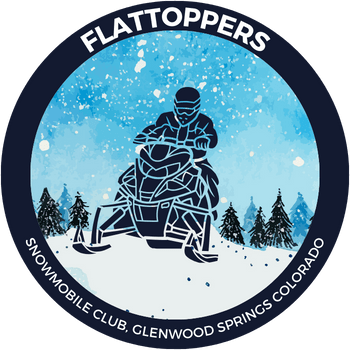Safety Information
Snowmobiling in the wilderness of Colorado takes extra skills not required in the Midwest. Learn to build a fire, Learn to build overnight shelter, Never travel alone, be prepared for an overnight stay.
CSA Safety List
1. Never travel alone.
2. Tell someone your destination, routs, and when you plan to return.
3. Don’t drink and ride
4. Slow down, especially at night.
5. Keep to the right when trail riding.
6. Watch for skiers, snowshoers, dogsleds, wildlife and give them room.
7. Use caution when crossing lakes & streams.
8. Dress appropriately & wear a helmet.
9. Respect private property.
10. Be familiar with your snowmobile, carry extra spark plugs, drive belt, tool kit, and a tow rope.
11. Carry a survival kit with a map, compass, flashlight, extra food & dry clothing, sunglasses, first-aid, knife, saw, waterproof matches or lighter flint or fire sticks, candles, space blanket.
12. Watch for trail grooming equipment.
13. Watch for other sledders needing assistance.
State Parks Service List Basic snowmobile safety code:
* Be sure your snowmobile is in top-notch mechanical condition at the beginning of the winter and throughout the season.
* Read the snowmobile manual to familiarize yourself with the snowmobile you are driving.
* Wear sensible, protective clothing designed for snowmobiling.
* Use a full-size helmet, goggles or face shield to prevent injuries from twigs, stones, ice chips and flying debris.
* Do not wear long scarves. They can get caught in the moving parts of the snowmobile.
* Know the terrain you are going to ride. If it is unfamiliar to you ask someone who has traveled over it before. Don’t travel on unfamiliar ground at night.
* Know the weather forecast and the ice and snow conditions in the area.
* Always use the buddy system. Never ride alone.
* Do not pursue domestic or wild animals. If you see a violation of this rule, report it to the nearest law enforcement officer.
* Have a proper lighting system on the snowmobile.
* Snowmobile headlights are adequate for reduced speeds only, don’t overdrive the machine’s headlights and make sure your taillights are free of snow.
* Drowning is one cause of snowmobile fatalities.
* Be familiar with the thickness of the ice and water currents.
* Don’t remove the factory-installed air box or muffer to install a noisier one. This will lessen the performance of your vehicle.
* Carry a flashlight or flare for emergency signaling.
* Never blaze a new trail at night.
* Use caution when riding in freezing rain because your goggles may freeze over.
Be smart when you ride, when your tired call it a day, you make the most mistakes when you are too tired to ride. Always stay together, keep an eye out for your sledding mates, and regroup from time to time to make sure you haven’t lost anyone. Ride within your ability, and within you machines ability, don’t try to go places that will get you into trouble, unless you know you can get out. Don’t push your machine too hard, it will fail on you if you do, and then you’ll be in a repair / recovery situation. Don’t abandon your group unless you let the others know you will. In all cases keep your head, keep your cool, and stay together if you can. Always confirm all of your party has made it out, and if they have not made it out, organize a search party with other qualified riders, or contact emergency services 911.
